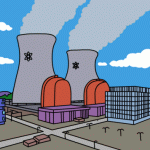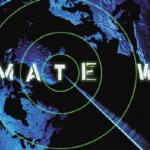Environment
This weekend, ScienceBloggers discussed the virtues and downfalls of a world run on modern nuclear power. Benjamin Cohen sparked the dialogue on The World's Fair with an interview with author and environmentalist Rebecca Solnit, famous for her opposition to nuclear power. Within just a few hours, Built on Fact's Matt Springer responded, categorically arguing against Solnit's piece and citing events at Chernobyl as an overly hyped specter. "Chernobyl is to modern nuclear power as bloodletting is to penicillin," he says. Ethan Siegel followed in suit on Starts with a Bang, where he offered…
One nice new feature we've got here on scienceblogs is the Editor's Picks feature, found on the front page. While browsing it this weekend, I was drawn to this provocative article. In it, Benjamin Cohen writes of his interview with Rebecca Solnit, who says the following when asked about nuclear power as a viable solution to our energy concerns:
Well, the first problem is that they still think like big science--that there is "the answer." In fact, there are hundreds of little answers that don't include nuclear, including scaling back our consumption and travel and building better and using a…
Sipping from the internet firehose...
This weekly posting is brought to you courtesy of H.E.Taylor. Happy reading, I hope you enjoy this week's Global Warming news roundup
skip to bottom Another week of Climate Disruption News September 6, 2009 Chuckle, WCC, Royal Society on GeoEngineering, Himalayan Conference, Thailand, 10:10, G20 Melting Arctic, Kaufman et al., Methane, Geopolitics, Antarctica Tipping Points, Sunspots, Money, Tobis, Grumbine, Late Comments Food Crisis, Food vs. Biofuel, Food Production Hurricanes, GHGs, C & N Cycles, Temperatures, Feedbacks, Aerosols…
Here are the submissions for OpenLab 2009 to date. As we have surpassed 340 entries, all of them, as well as the "submit" buttons and codes and the bookmarklet, are under the fold. You can buy the 2006, 2007 and 2008 editions at Lulu.com. Please use the submission form to add more of your and other people's posts (remember that we are looking for original poems, art, cartoons and comics, as well as essays):
2020 Science: Hooked on science - ten things that inspired me to become a scientist
A Blog Around The Clock: On Being a Nurse- a guest post
A Blog Around The Clock: Why social insects…
Here are the submissions for OpenLab 2009 to date. As we have surpassed 340 entries, all of them, as well as the "submit" buttons and codes and the bookmarklet, are under the fold. You can buy the 2006, 2007 and 2008 editions at Lulu.com. Please use the submission form to add more of your and other people's posts (remember that we are looking for original poems, art, cartoons and comics, as well as essays):
2020 Science: Hooked on science - ten things that inspired me to become a scientist
A Blog Around The Clock: On Being a Nurse- a guest post
A Blog Around The Clock: Why social insects…
[sorry to be late this week, folks. I am in Australia on business and it took 34 hours to get here and I only got internet access where I am staying just now. Better late than never, no?]
Sipping from the internet firehose...
This weekly posting is brought to you courtesy of H.E.Taylor. Happy reading, I hope you enjoy this week's Global Warming news roundup
skip to bottom Another week of Climate Disruption News August 30, 2009 Chuckle, Pachauri - 350, Solar Cycle Climate Link, Adaptation Costs, Bonner, API, WCC, Himalayan Conference Melting Arctic, Geopolitics, Antarctica,…
tags: Birds in the News, BirdNews, ornithology, birds, avian, newsletter
Sandwich Tern, Sterna sandvicensis, photographed at the Bolivar Ferry, Texas.
Image: Joseph Kennedy, 4 August 2009 [larger view].
Birds and Technology
Rather than searching for weird weather or enemy missiles, some satellites are helping researchers to track -- and predict -- the spread of deadly diseases. With the pandemic spread of H1N1 swine flu and the continued advance of the H5N1 avian flu, scientists are anxious to better predict the spread of infectious diseases and are looking for new tools wherever they…
PZ Myers is upset - and rightly so - at something that Pope Benedict XVI said in a speech he gave at Wednesday's General Audience. The Pope, while speaking on the topic of environmentalism, suggested that disrespect for the environment stems from disbelief in God:
Is it not true that inconsiderate use of creation begins where God is marginalized or also where is existence is denied? If the human creature's relationship with the Creator weakens, matter is reduced to egoistic possession, man becomes the "final authority," and the objective of existence is reduced to a feverish race to…
My regular readers probably remember that I blogged from the XXVI International Association of Science Parks World Conference on Science & Technology Parks in Raleigh, back in June of this year.
I spent the day today at the headquarters of the Research Triangle Park, participating in a workshop about the new directions that the park will make in the future. It is too early to blog about the results of this session, though the process will be open, but I thought this would be a good time to re-post what I wrote from the June conference and my ideas about the future of science-technology…
Here is a major press release by Elizabeth K. Gardner on the link between climate change and poverty, reproduced below the fold for your edification.
~ ~ ~ ~ ~ ~
WEST LAFAYETTE, Ind. - Urban workers could suffer most from climate change as the cost of food drives them into poverty, according to a new study that quantifies the effects of climate on the world's poor populations.
A team led by Purdue University researchers examined the potential economic influence of adverse climate events, such as heat waves, drought and heavy rains, on those in 16 developing countries. Urban workers in…
Tips for flourishing after a mass extinction. Ceratites nodosus (MCZ-7232) (A), from the Triassic of Germany, was similar to the ceratitid ammonoid species that thrived in the water column in the Early Triassic (1), while bottom-dwelling species languished. Key to the ceratitids' rapid success after the end-Permian mass extinction were their ecological tolerances, which may be inferred by reference to their closest living relatives, the coleoids (squids, octopuses, and cuttlefish), including the low-oxygen specialist Vampyroteuthis infernalis (B).
This picture has a little story behind it.…
From Aard regular CCBC, a heritage management conundrum to ponder.
This is a curious situation that I heard about on metafilter.com. I have included some of the links.
Near Kaufdorf, Switzerland there is an auto junkyard that was in use from the 1930s to 1970. It has become overgrown with various forest flora and people have found it an interesting place to take photos. Recently, the Swiss government has decreed the place an environmental hazard and says that it must be cleared and paved to prevent fluids from seeping into the ground. Many people have protested on the grounds that:
This is…
"They say rather than cursing the darkness, one should light a candle. They don't mention anything about cursing a lack of candles."
- George Carlin, When Will Jesus Bring the Porkchops?
In Unscientific America, Chris Mooney and Sheril Kirshenbaum (the latter of whom I consider a friend) are deeply concerned that the American system is unsustainable so long as scientific results and recommendations are not appreciated by the general public or by the politicians that represent us. And there is good reason to be concerned. In their book they cite the results of a 2008 report from the Keystone…
tags: Birds in the News, BirdNews, ornithology, birds, avian, newsletter
Black-crowned Night-Heron, Nycticorax nycticorax, photographed at Brazos Bend State Park, Texas.
Image: Joseph Kennedy, 7 August 2009 [larger view].
Nikon D200, Kowa 883 telescope with TSN-PZ camera eyepiece 1/180s f/8.0 at 1000.0mm iso400.
Birds in Science
Brainy male birds are more sexually attractive to female birds, scientists have discovered. Researchers gave male bowerbirds a set of cognitive tests to evaluate their problem solving ability. Bowerbirds that performed well in the tests also mated with the most…
Another look at falsehoods about evolution.
We previously addressed the falsehood "Evolution has stopped for humans" and concluded that background change in allele frequency independent of natural selection does not just stop for any viable, continuing population. So, no, saying that "evolution has stopped for humans" is tantamount to saying that "gravity has stopped for my coffee cup" (which is sitting here on my desk minding its own business).
But this question is a falsehood at another level. In reality, there are two additional questions that are actually being asked when this…
Sipping from the internet firehose...
This weekly posting is brought to you courtesy of H. E. Taylor. Happy reading, I hope you enjoy this week's Global Warming news roundup
skip to bottom Another week of Climate Disruption News Information overload is pattern recognition August 23, 2009 Chuckle, Alberta Clipper, RET, World Water Week, Bonner, API, Costs Melting Arctic, Geopolitics, Antarctica, Methane, Carbon Tariffs, World Bank Misdirection, Late Comments Food Crisis, Food vs. Biofuel, Food Production Hurricanes, GHGs, Temperatures, Feedbacks, Aerosols, Paleoclimate, ENSO,…
Sipping from the internet firehose...
This weekly posting is brought to you courtesy of H. E. Taylor. Happy reading, I hope you enjoy this week's Global Warming news roundup
skip to bottom Another week of Climate Disruption News Sipping from the internet firehose... August 16, 2009 Bonn, CPRS Vote, Volt 230, Clean Energy Summit Melting Arctic, Geopolitics, Antarctica, Methane, Carbon Tariffs, Real Climate, Bonner, Late Comments Food Crisis, Food vs. Biofuel, Food Production Hurricanes, GHGs, Carbon Cycle, Temperatures, Feedbacks, Clouds, Ozone, Paleoclimate, Glaciers, Satellites…
When the bacteria that cause anthrax (Bacillus anthracis) aren't ravaging livestock or being used in acts of bioterrorism, they spend their lives as dormant spores. In these inert but hardy forms, the bacteria can weather tough environmental conditions while lying in wait for their next host. This is the standard explanation for what B.anthracis does between infections, and it's too simple by far. It turns out that the bacterium has a far more interesting secret life involving two unusual partners - viruses and earthworms.
A dying animal can release up to a billion bacterial cells in every…
The New York Times led their Sunday edition with an article by John Broder focusing on recent Defense department conclusions on the national security risks of climate change. Here's the key takeaway from the article on what it could mean for re-framing the debate over cap and trade legislation for fence-sitters in the Senate:
Much of the public and political debate on global warming has focused on finding substitutes for fossil fuels, reducing emissions that contribute to greenhouse gases and furthering negotiations toward an international climate treaty -- not potential security challenges…
Sipping from the internet firehose...
This weekly posting is brought to you courtesy of H. E. Taylor. Happy reading, I hope you enjoy this week's Global Warming news roundup
skip to bottom Another week of Climate Disruption News Another Week of Global Warming News Information overload is pattern recognition August 9, 2009 Chuckle, Coal Fight, Bonner & Assoc., USGS, Pacific Island States, Cash4Clunkers, EPRI Melting Arctic, Geopolitics, Methane, Antarctica, Carbon Tariffs, APA, Milankovitch, Late Comments Food Crisis, Food Production Hurricanes, GHGs, Carbon Cycle, Temperatures…


